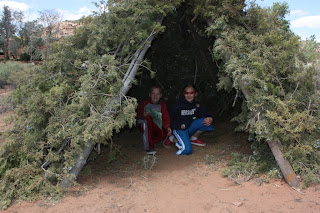Pipe Spring National Monument
Dave left early (some people probably thought he was even
earlier – we remained on Mountain time although for this one night, we had
crossed over into the West Coast time zone) to drive out to Cape Royal about 45
minutes away. This is the furthest
driveable point on the North Rim. He
also stopped at Angels Window and Walhalla Overlook on that side of the
Canyon. While he was gone, the kids
finished off their JR books. Apparently
it was still ridiculously windy, but he managed a few good pictures. One comment he made was that the sand had
been clearly swirling in the base of the Canyon, so those poor folks who had
trekked down to the base were probably not having the best time! Additionally the waterpipe, which takes water
from the rim to the base of the Canyon, had developed a leak, so anyone hiking
down had to take all their water or purification tabs.
On Dave’s return (after finding all the kids cuddled in our bed - it was chilly!), we headed back to the Visitor Center
where the Ranger really praised the kids for all of their hard work completing
the entire book. Once they were sworn
in, we hooked the camper back up and sadly left Grand Canyon National Park,
passing deer and some struggling cyclists on the way.
It was with much relief that our drive time was only about
three hours today. On the way from one
National Park to the next, we made a stop at Pipe Spring
National Monument. We had pre-warned the kids that another JR
program was incoming! It wasn’t too
taxing – the blessing of a smaller NPS site is that it’s possible to see
everything in a reasonably short time.
From the brochure: Water
is a powerful force in human affairs.
For millennia Pipe Spring has drawn a succession of peoples – either as
an oasis on their journeys or as a water source for permanent settlements. It is an arid and seemingly uninhabitable
region but hidden geological forces have brought water for a few places here,
opening them to human settlement. The
Strip is the first in a series of terraces that step up to the high plateau of
central Utah
some 200 miles to the north. There,
water from rain and snowmelt percolates down to a hard shale layer and flows
southward to the base of the Vermilion Cliffs, where it is forced to the
surface at places such as Pipe Spring.
For 12,000 years the
Strip was a travel corridor for nomadic big game hunters. Ancestral Puebloan peoples were the next to
settle in the area, followed by related Southern Paiute tribes who live here
still. Beginning in the 1700s,
missionaries and explorers visited the area.
In the mid-1800s the Church of Jesus Christ of Latter-Day Saints came
upon the Arizona
Strip while seeking water and land to expand their new homeland in the
West. Each of these cultures affected how
the others adapted to this hard and demanding place in the high desert.
Due to over grazing by the settlers, the land sadly did not
yield all it had previously given and the homesteads set up here were
abandoned. There were two long-horns on
the site, amazing to see these animals up close.
We spent some time in the Visitor Center
and then outside looking at the machinery and tools used by the settlers as
well as wandering in the basic cabins.
A Ranger conducted a tour of the main house, named Winsor Castle
for the first family who settled here.
Evidently there was much tension between the settlers and the Indians
involving bloodshed on both sides. As
such, when the house was built, it included small gun windows and a high look
out tower. None of these were ever
needed as the house did not come under attack.
It ran successfully as a stopping point for food, water, and board as
well as producing large quantities of dairy products to sell such as butter and
cheese.
A telegraph operation was also set up here. After John Wesley Powell, on his journey to
survey the Colorado River, informed them that their property was actually in Arizona, not Utah, they
realized that theirs was the first telegraph operation in Arizona!
We love learning about these little slices of history. Hopefully this hands-on learning will serve
the kids well in the future and help them retain some of what they hear. After admiring the still-harvested grape vines, they were sworn in for the second time that
day as Junior Rangers.
We made it to Zion River Resort by late afternoon, having passed the outside towering rocks of Zion National Park, and the
younger three patiently waited until we were set up to go in the pool. Given the winds, I can’t imagine it was
terribly warm but they were not remotely perturbed – there was a pool, it was
open, they should swim!


































































Comments